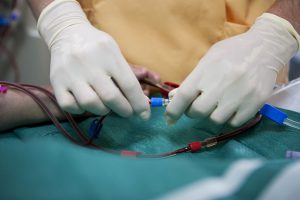Tissue-Engineered Blood Vessels May Replace Grafts for Dialysis

Artificial, tissue-engineered blood vessels may prove safer and more durable for patients receiving hemodialysis who are often forced to replace synthetic arteriovenous (AV) grafts because of their failure after extensive use.
A study published May 12, 2016, in The Lancet documents the development of artificial blood vessels by researchers at Duke University, Yale University, and Humacyte, a tissue engineering company located in Morrisville, NC. The findings were based on a phase 2 trial among 60 study patients with kidney failure who required dialysis.
“Vascular access is the Achilles heel of hemodialysis,” says Matthew A. Sparks, MD, a Duke Health nephrologist. “It’s a huge component of patient morbidity. Some patients simply exhaust their options. Clinicians recognize the superiority of a native AV fistula,” he adds. “But many patients struggle with repeated access failures, so even at this early stage, the research holds promise.”
The Duke and Yale research team—along with surgeons in Poland and the United States and scientists at Humacyte, the company developing the bioengineered blood vessel—tested human acellular vessel, manufactured to be available on demand.
“The bioengineered blood vessel represents a critical step in tissue engineering,” says study author Jeffrey Lawson, MD, PhD, professor of surgery and pathology at Duke and chief medical officer of Humacyte. “Because these vessels contain no living cells, patients have access to off-the-shelf engineered grafts that can be used without any waiting period associated with tailormade products.”
To create the vessels, the researchers isolate vascular cells from human donors and grow them in tissue culture. The cellular tissue is placed on a degradable scaffold shaped like a blood vessel, bathed in nutrients, and stretched while growing to acquire the physical properties of blood vessels. After 8 weeks, the scaffold degrades, leaving the engineered tissue alone.
In the final step, the cells are washed away with a special solution. The remaining tissue retains the structure of the vessel but none of the components that could cause tissue rejection.
“This technology represents a potential improvement over the polytetrafluoroethylene (PTFE) graft we often use in dialysis,” says Sparks.
Although the study size was small, Sparks notes that the development may help patients avoid catheters, which present the highest risk to patients on dialysis. “This engineered tissue would be implanted,” he notes. “The hope is that risk of infection would be lower than that of a catheter or even a PTFE graft. There is a great need to develop better graft material,” he adds. “Certainly tissue engineering has the potential to be a significant step forward.”